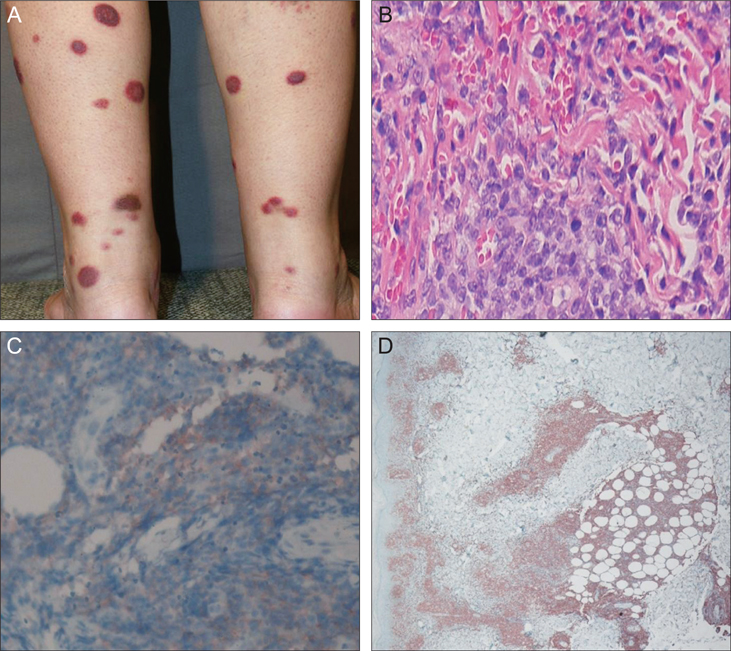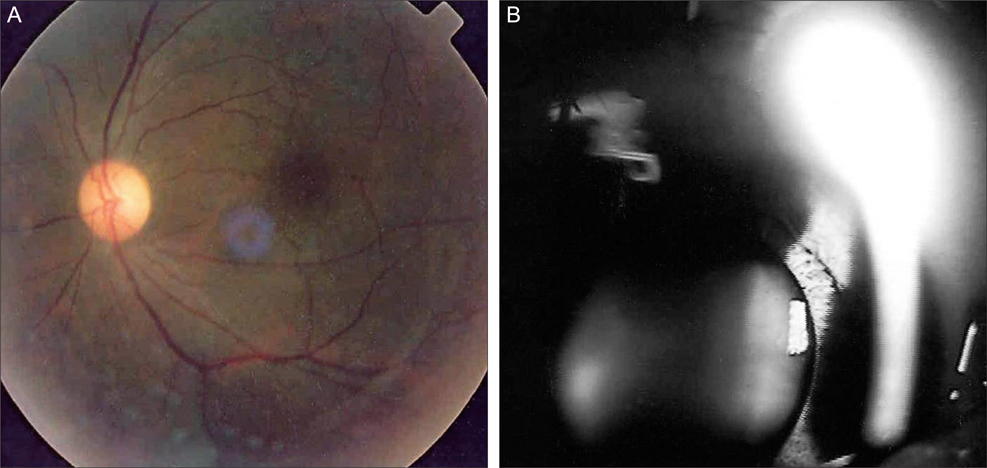Korean J Ophthalmol.
2012 Feb;26(1):54-57. 10.3341/kjo.2012.26.1.54.
Intraocular Involvement of a Nasal Natural Killer T-Cell Lymphoma: A Case Report
- Affiliations
-
- 1Department of Ophthalmology, Kosin University College of Medicine, Busan, Korea. hiatus@ns.kosinmed.co.kr
- KMID: 1120183
- DOI: http://doi.org/10.3341/kjo.2012.26.1.54
Abstract
- Herein, we report a case of nasal natural killer T-cell lymphoma (NKTL) with intraocular involvement. A 57-year-old woman was referred due to a three-day history of photophobia and diplopia in the left eye. One-month previously, she was diagnosed with nasal NKTL of the right nasal cavity. Ophthalmic examination revealed conjunctival injection and ptosis. The left pupil was fully dilated and non-reactive to light. Ocular motion was restricted on left-upper gaze. Five days later, anterior uveitis developed and persisted despite topical steroid treatment. An orbital magnetic resonance imaging was without specific findings, however, ophthalmoplegia, vitreous opacity, and an iris mass were observed. A diagnostic anterior chamber aspiration was performed. Aqueous humor aspiration revealed 35% morphologically atypical lymphocytes. After an intravitreal triamcinolone injection, radiotherapy and chemotherapy were administered; this resolved the uveitis and iris mass. When refractory uveitis or orbital pseudotumor occurs in patients with nasal NKTL, ocular and orbital involvement of the NKTL should be considered.
Keyword
MeSH Terms
Figure
Reference
-
1. Choi KH, Lee SJ, Suh YL, Kim YD. Nasal-type natural killer/T-cell lymphoma of the orbit. J Korean Ophthalmol Soc. 2004. 45:2145–2150.2. Coupland SE, Krause L, Delecluse HJ, et al. Lymphoproliferative lesions of the ocular adnexa. Analysis of 112 cases. Ophthalmology. 1998. 105:1430–1441.3. Cimino L, Chan CC, Shen D, et al. Ocular involvement in nasal natural killer T-cell lymphoma. Int Ophthalmol. 2009. 29:275–279.4. Hon C, Kwok AK, Shek TW, et al. Vision-threatening complications of nasal T/NK lymphoma. Am J Ophthalmol. 2002. 134:406–410.5. Al-Hakeem DA, Fedele S, Carlos R, Porter S. Extranodal NK/T-cell lymphoma, nasal type. Oral Oncol. 2007. 43:4–14.6. Woog JJ, Kim YD, Yeatts RP, et al. Natural killer/T-cell lymphoma with ocular and adnexal involvement. Ophthalmology. 2006. 113:140–147.7. Nakamura S, Suchi T, Koshikawa T, et al. Clinicopathologic study of CD56 (NCAM)-positive angiocentric lymphoma occurring in sites other than the upper and lower respiratory tract. Am J Surg Pathol. 1995. 19:284–296.8. Cheung MM, Chan JK, Lau WH, et al. Primary non-Hodgkin's lymphoma of the nose and nasopharynx: clinical features, tumor immunophenotype, and treatment outcome in 113 patients. J Clin Oncol. 1998. 16:70–77.9. Chan JK, Sin VC, Wong KF, et al. Nonnasal lymphoma expressing the natural killer cell marker CD56: a clinicopathologic study of 49 cases of an uncommon aggressive neoplasm. Blood. 1997. 89:4501–4513.10. Chan JK. Natural killer cell neoplasms. Anat Pathol. 1998. 3:77–145.
- Full Text Links
- Actions
-
Cited
- CITED
-
- Close
- Share
- Similar articles
-
- A Case of Primary Nasal CD56+ NK/T cell Lymphoma with Cutaneous Involvement
- A Case of Natural Killer T-cell Lymphoma of the Tongue
- A Case of Nasal Type NK/T-cell Lymphoma
- Natural Killer T-cell Lymphoma Presented With Ophthalmoplegia
- A Case of Nasal CD56+ NK/T Cell Lymphoma Mimicking Cellulitis which Developed after Persistent Orbital Swelling




